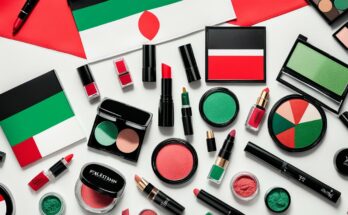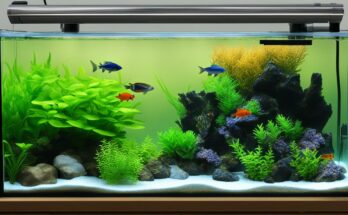Drying your hair without a blow dryer can be a quick and easy process. By using air drying techniques and natural methods, you can protect your hair from heat damage while still achieving a great style. Let’s explore some helpful tips for drying your hair without a blow dryer.
Key Takeaways:
- Air drying your hair is a healthy alternative to using a blow dryer.
- Choosing the right towel and comb can minimize heat damage.
- Using quick-dry lotions and air-dry formulas can speed up the drying process.
- Proper techniques like rough-drying and focusing on the roots can reduce frizz.
- Alternative methods like towel turbans and plopping can further enhance the air drying process.
The Right Towel and Comb
One of the first steps in air drying your hair is selecting the right towel and comb. Microfiber towels are highly recommended as they are known for their ability to absorb water quickly without causing friction or damage to the hair. A wide-tooth comb should also be used to gently detangle and promote airflow, which helps in accelerating the drying process. By utilizing the right towel and comb, you can effectively reduce heat damage to your hair while allowing it to dry naturally.
Choosing the right towel for towel drying hair is important because it can make a significant difference in the health and appearance of your hair. Microfiber towels are specially designed to be gentle on hair strands while effectively absorbing excess water. Unlike regular towels, the soft fibers of microfiber towels minimize friction and prevent hair breakage, making them an ideal choice for towel drying.
Wide-tooth combs are essential tools for hair care, particularly when towel drying hair. Unlike fine-tooth combs or brushes, wide-tooth combs have wider gaps between the teeth, allowing them to glide through wet hair more easily. This helps to minimize tugging and breakage, enabling the hair to dry without causing damage. Additionally, wide-tooth combs help to distribute natural oils evenly throughout the hair, promoting overall hair health.
“Using microfiber towels and wide-tooth combs is a simple yet effective way to reduce heat damage while towel drying hair.”
Benefits of Using Microfiber Towels:
- Quickly absorbs excess water
- Gentle on hair strands
- Reduces friction and hair breakage
- Promotes smoother and healthier hair
Advantages of Using a Wide-Tooth Comb:
- Gently detangles wet hair
- Promotes airflow for faster drying
- Minimizes breakage and hair damage
- Distributes natural oils for healthier hair
| Microfiber Towel | Regular Towel | |
|---|---|---|
| Absorption | Highly absorbent, quickly dries hair | Less absorbent, takes longer to dry hair |
| Friction | Minimal friction, reduces hair breakage | More friction, can cause hair breakage |
| Texture | Soft, gentle fibers | Rough, abrasive fibers |
| Effect on Hair | Leaves hair smoother and healthier | Can leave hair rough and prone to frizz |
Choosing the right towel and comb is a simple yet important step in reducing heat damage while drying your hair naturally. By using a microfiber towel and a wide-tooth comb, you can ensure that your hair dries gently and without causing unnecessary stress or breakage. Incorporating these tools into your air drying routine will help you achieve beautiful, healthy-looking hair.
The Importance of Product Choice
Choosing the right products for air drying is crucial to achieve the desired results. When it comes to drying your hair without a blow dryer, quick-dry lotions and air-dry formulas are your best allies. These specially formulated products are designed to expedite the drying process while reducing heat damage on hair.
Quick-dry lotions or serums can be applied to semi-dry hair to accelerate the drying time. These products contain unique ingredients that help absorb moisture and speed up the natural drying process. Unlike traditional blow-dry creams, quick-dry lotions do not require heat to work effectively.
Air-dry formulas, on the other hand, are specifically crafted with starches that aid in soaking up excess moisture from the hair. These formulas provide a sleek and frizz-free finish, making them ideal for achieving a polished air-dried hairstyle.
By selecting the right products, you can minimize heat damage on your hair and achieve professional-looking results. Experiment with different quick-dry lotions and air-dry formulas to find the one that works best for your hair type and desired style. Invest in high-quality products that prioritize the health of your hair while enhancing its natural beauty.
Proper Techniques for Air Drying
When it comes to air drying your hair, there are specific techniques you can use to enhance the process and achieve the best results. By incorporating these proper techniques, you can rough-dry your hair, accelerate dry time, and reduce frizz for a flawless air-dried hairstyle.
Tousling for Volume and Texture
If you want to add more volume and texture to your air-dried hair, try rough-drying it by gently tousling it with your fingers. This technique helps create lift and body at the roots, resulting in a fuller and more voluminous look. By separating the hair strands and gently tousling them, you can also enhance the natural texture of your hair.
Focusing on the Roots
When air drying your hair, it’s essential to pay special attention to the roots. By focusing on drying the roots first, you can speed up the drying process as the roots tend to dry faster than the ends. Continuously fluffing the roots and using your fingers to separate the hair strands will help promote better airflow, allowing your hair to dry more quickly.
Promoting Better Airflow
Another key technique for air drying is to continuously fluff the roots and separate the hair strands throughout the drying process. This helps promote better airflow, which is crucial for reducing dry time and minimizing frizz. By creating space between the hair strands, you allow the air to circulate more effectively, resulting in faster drying times and a smoother, frizz-free finish.
By utilizing these proper techniques for air drying, you can achieve beautiful, salon-worthy results without the need for a blow dryer. Not only will you reduce the risk of heat damage, but you’ll also enjoy the natural texture and added volume that air drying provides.
Now, let’s continue exploring alternative methods for drying your hair without a blow dryer in Section 5.
Alternative Methods for Drying
In addition to traditional air drying techniques, there are alternative methods that can be used to dry your hair without a blow dryer. These methods are not only effective in reducing drying time but also provide additional benefits such as reducing frizz. Let’s explore two popular alternatives: towel turbans and plopping.
Towel Turbans
Using towel turbans is a simple yet efficient way to accelerate the drying process. To create a towel turban, follow these steps:
- Step 1: After washing your hair, gently squeeze out excess water.
- Step 2: Take a soft microfiber towel and lay it flat on a surface.
- Step 3: Flip your hair forward and place the top center of the towel at the nape of your neck.
- Step 4: Gather the ends of the towel and twist them together, creating a snug turban.
- Step 5: Secure the towel turban in place by tucking the twisted ends under the turban.

The towel turban will help absorb excess water from your hair and reduce frizz while allowing your hair to dry naturally. Leave the towel turban on for about 15-20 minutes or until your hair feels damp rather than wet.
Plopping Hair
Plopping is a popular method especially suitable for those with curly hair. It helps enhance curl definition and minimize frizz during the drying process. Here’s how to plop your hair:
- Step 1: Start with freshly washed hair.
- Step 2: Lay a soft T-shirt flat on a surface.
- Step 3: Flip your hair forward and gently lower your hair onto the center of the T-shirt, with the ends of your hair resting near the nape of your neck.
- Step 4: Place your hands on either side of the T-shirt, tucking the sides of the T-shirt firmly against your head.
- Step 5: Carefully twist the remaining length of the T-shirt, creating a secure wrap.

Leave your hair wrapped in the plop for about 30 minutes to an hour, allowing your hair to dry and the curls to set. Unwrap the T-shirt gently and let your hair fall naturally.
By exploring these alternative methods like towel turbans and plopping, you can find the best approach for your hair type and reduce frizz while drying your hair naturally.
Conclusion
Drying your hair naturally without the use of a blow dryer is not only possible, but it also offers numerous benefits for your hair’s health. By following these best ways to dry hair naturally and exploring heatless hair drying techniques, you can achieve beautiful, air-dried hair while minimizing heat damage.
Utilizing the right tools and products is crucial in achieving the desired results. Choose a microfiber towel for effective water absorption without causing friction or damage to your hair. Use a wide-tooth comb to gently detangle and promote airflow, allowing your hair to dry naturally.
In addition, selecting the right products, such as quick-dry lotions or air-dry formulas, can significantly reduce drying time while providing a sleek, frizz-free finish. These specially formulated products are designed to enhance the air drying process, unlike traditional blow-dry creams.
Exploring alternative methods, such as towel turbans or plopping, can also help in reducing drying time and frizz. Find the technique that works best for your hair type and embrace natural hair drying techniques to enjoy the benefits of a heatless hairstyling routine.
FAQ
How can I dry my hair without a blow dryer?
There are several methods you can try to dry your hair without a blow dryer. Air drying, towel drying, and using alternative techniques such as towel turbans and plopping are all effective options.
What kind of towel should I use to dry my hair?
It is recommended to use a microfiber towel for drying your hair. Microfiber towels are gentle on the hair, absorb water quickly, and help reduce friction and damage.
What type of comb should I use for air drying?
A wide-tooth comb is best for air drying as it gently detangles the hair and promotes airflow, which aids in the drying process.
Are there any products I can use to speed up the air drying process?
Yes, there are quick-dry lotions or serums available that can be applied to semi-dry hair to accelerate the drying time. These products are specifically formulated for air drying and provide a sleek, frizz-free finish.
How can I rough-dry my hair to speed up the drying process?
Rough-drying involves gently tousling the hair with your fingers to create more volume at the roots, which helps accelerate dry time. It also adds texture to the hair.
What are alternative methods for drying hair without a blow dryer?
Towel turbans and plopping are two popular alternative methods. Towel turbans involve wrapping your hair in a microfiber towel to absorb moisture and reduce drying time. Plopping is a technique used for air drying curly hair, which involves wrapping the hair in a t-shirt to enhance curl definition and minimize frizz.
Is air drying better for my hair than blow drying?
Air drying is generally considered healthier for the hair as it reduces heat damage. However, it is important to find the best drying method for your hair type and personal preferences.




